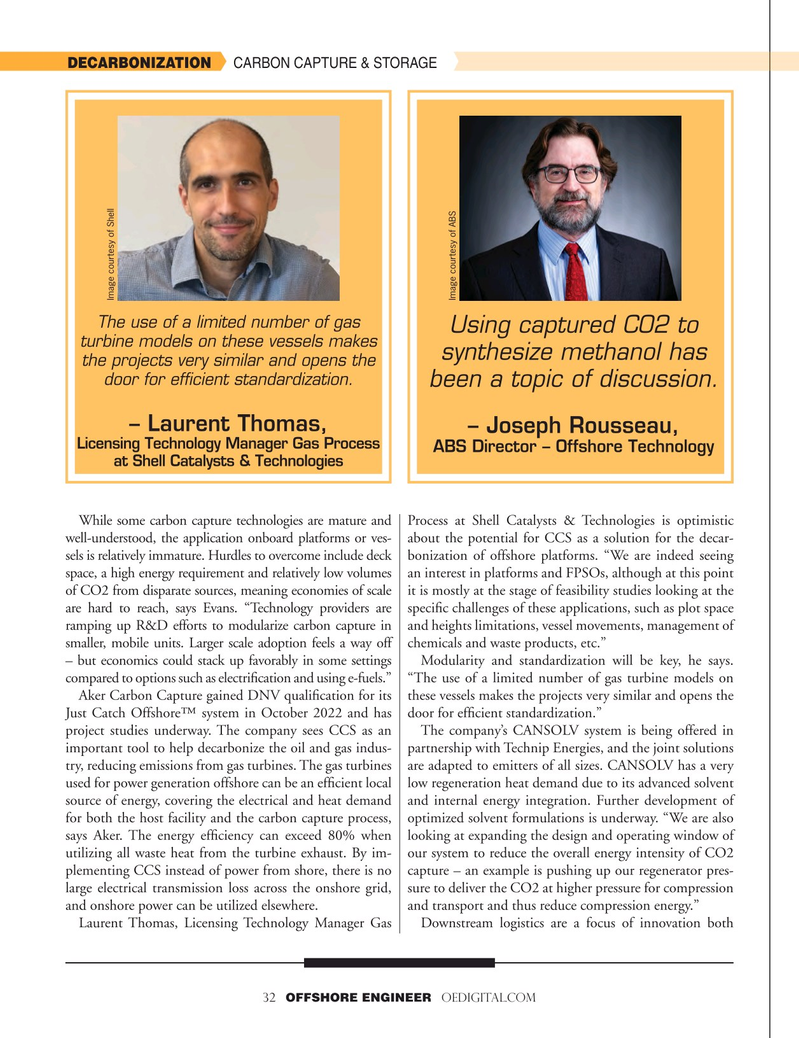
Page 32: of Offshore Engineer Magazine (Nov/Dec 2023)
Read this page in Pdf, Flash or Html5 edition of Nov/Dec 2023 Offshore Engineer Magazine
DECARBONIZATION CARBON CAPTURE & STORAGE
Image courtesy of Shell
Image courtesy of ABS
The use of a limited number of gas
Using captured CO2 to turbine models on these vessels makes synthesize methanol has the projects very similar and opens the door for efficient standardization.
been a topic of discussion.
– Laurent Thomas, – Joseph Rousseau,
Licensing Technology Manager Gas Process
ABS Director – Offshore Technology at Shell Catalysts & Technologies
While some carbon capture technologies are mature and Process at Shell Catalysts & Technologies is optimistic well-understood, the application onboard platforms or ves- about the potential for CCS as a solution for the decar- sels is relatively immature. Hurdles to overcome include deck bonization of offshore platforms. “We are indeed seeing space, a high energy requirement and relatively low volumes an interest in platforms and FPSOs, although at this point of CO2 from disparate sources, meaning economies of scale it is mostly at the stage of feasibility studies looking at the are hard to reach, says Evans. “Technology providers are specifc challenges of these applications, such as plot space ramping up R&D efforts to modularize carbon capture in and heights limitations, vessel movements, management of smaller, mobile units. Larger scale adoption feels a way off chemicals and waste products, etc.” – but economics could stack up favorably in some settings Modularity and standardization will be key, he says. compared to options such as electrifcation and using e-fuels.” “The use of a limited number of gas turbine models on
Aker Carbon Capture gained DNV qualifcation for its these vessels makes the projects very similar and opens the
Just Catch Offshore™ system in October 2022 and has door for effcient standardization.” project studies underway. The company sees CCS as an The company’s CANSOLV system is being offered in important tool to help decarbonize the oil and gas indus- partnership with Technip Energies, and the joint solutions try, reducing emissions from gas turbines. The gas turbines are adapted to emitters of all sizes. CANSOLV has a very used for power generation offshore can be an effcient local low regeneration heat demand due to its advanced solvent source of energy, covering the electrical and heat demand and internal energy integration. Further development of for both the host facility and the carbon capture process, optimized solvent formulations is underway. “We are also says Aker. The energy effciency can exceed 80% when looking at expanding the design and operating window of utilizing all waste heat from the turbine exhaust. By im- our system to reduce the overall energy intensity of CO2 plementing CCS instead of power from shore, there is no capture – an example is pushing up our regenerator pres- large electrical transmission loss across the onshore grid, sure to deliver the CO2 at higher pressure for compression and onshore power can be utilized elsewhere. and transport and thus reduce compression energy.”
Laurent Thomas, Licensing Technology Manager Gas Downstream logistics are a focus of innovation both 32 OFFSHORE ENGINEER OEDIGITAL.COM

 31
31

 33
33